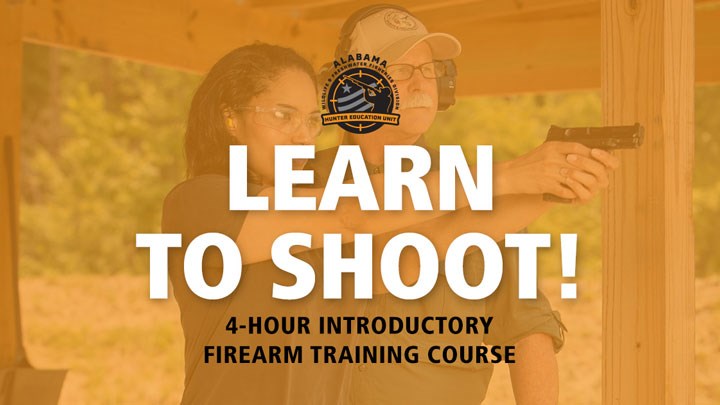
by Chris Chaffin - Thursday, May 13, 2021

Last year brought an influx of new gun owners, with over eight million sales reported—a trend that continues in 2021. Recognizing a demand for basic training in handgun safety and use, the Alabama Wildlife and Freshwater Fisheries (WFF) Division’s Law Enforcement Section of the Alabama Department of Conservation and Natural Resources (DCNR) responded by creating a new course, “Firearms 101: Introduction to Handguns (ITH),” to teach gun safety and marksmanship to new gun owners and shooters. Officers of the WFF Law Enforcement Section and its Hunter Education Unit are now offering the classes at public shooting ranges around the state with the inaugural course held in April.
While participation is open to everyone, the four-hour ITH course is tailored to those who are thinking about purchasing a firearm or have already purchased one and need to learn about safe gun handling and storage, the parts of semi-automatic pistols and revolvers, and marksmanship fundamentals. The course provides instruction in a comfortable, controlled, family-oriented environment and is ideal for those who may be timid about going to a shooting range on their own. It is offered free of charge, with eye and ear protection, a .22 rimfire handgun and all ammunition provided. Participants who already have their own handgun and ammunition are welcome to bring them. The only course requirement is that everyone purchase an Alabama Wildlife Heritage License ($11.45, including range privileges), to help manage lands and sustain habitats for Alabama wildlife species.
Underscoring the need for the course, Chuck Sykes, Director of WFF said, “The DCNR felt a responsibility to help train these new gun owners in firearms safety, but also to educate them about what our department does and that they, along with hunters, are the people who actually pay for conservation through Pittman-Robertson Wildlife Restoration taxes.”
Did new gun owners really want this training? Apparently, yes.
“It’s worthy to note that a lot of recreational and new shooters actually recruit themselves in that they have an interest in shooting,” said Matt Weathers, ITH course supervisor and Section Chief of the WFF Division’s Law Enforcement Section, which oversees the state’s hunter education program. “What they need is a safe place to go and good instruction in the basics of safety and marksmanship—from qualified instructors. And Alabama’s WFF Division has both through the DCNR’s shooting ranges and our well-trained wardens. With these resources, we can effectively reach and train newcomers and cover the essential curriculum, specifically designed to teach firearms safety and marksmanship.”
But according to Weathers, the course does much more than that in generating both professional and personal interactions with Alabama citizens from diverse backgrounds—urban/rural, economic, cultural and racial. “In the mix, shooters and our wardens get to know each other, building trust and understanding,” he said.
For more course benefits, Weathers added, “Beyond the safety instruction, an important part of what takes place in these classes is that we help the students understand DCNR’s relevancy to their lives—what we are responsible for and what we do for them, how it impacts them, and that they are the ones who voluntarily pay for conservation, wildlife management and the shooting ranges, too. Most have no idea.”
To date the ITH course has been very successful, drawing more than 200 participants to the initial courses in just the first month with all classes filled to capacity. More classes are scheduled throughout May. (For the list of courses and locations, click here.) For more good news, the WFF is considering future expansion that also will include long-gun safety classes.
Weathers concluded, “We know not every student will become a hunter, but some will, and many others will have a better understanding of how conservation works, the role hunters and shooters play in conservation and, we think, more experience that will help them make informed decisions on wildlife and natural resources issues.”
Have the classes hit the bullseye? “So far,” Weathers observed. “No one has been unsatisfied, and we have a waiting list for future classes.”
About the Author
An outdoor communicator for more than 40 years, Chris Chaffin has worked with multiple outdoor companies, including serving two terms as treasurer of the Professional Outdoor Media Association before taking on the roles of vice president, president and chairman of the board. In 2007, he launched the communications consulting company Chaffin Communications, Inc. With support from the Outdoor Adventure Dream Giveaway, in 2012 he founded the Outdoor Adventure Conservation Fund, a Florida non-profit encouraging more people to get involved in traditional outdoor activities.
E-mail your comments/questions about this site to:
[email protected]
Proudly supported by The NRA Foundation and Friends of NRA fundraising.
